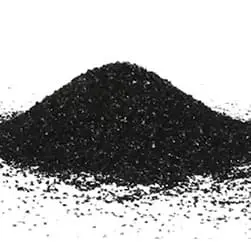IUPAC Name
Activated Carbon
Cas Number
7440-44-0
HS Code
3802.10.00
Formula
C
Industry
Water Treatment Chemicals
Appearance
Black Powder
Common Names
Activated coal, activated charcoal
Packaging
25 Kg Bag
Activated carbon, also known as activated charcoal or activated coal, is a form of carbon with small and low-volume pores which increases the surface area available to facilitate adsorption or chemical reactions. The increased surface area of activated carbon makes the material suitable for adsorption, a phenomenon where particles such as atoms, ions or molecules of gas, liquid or solid are adhered to a surface. These particles are held within the carbon’s internal pore structure by electrostatic attraction or chemisorption. This adsorption ability allows activated carbon to play an important role in many industries as it can help to reduce dangerous matter in chemical process, activate chemical reactions, and also act as a carrier for biomass and chemicals.
The most common product forms of activated carbon include:
• Extruded
• Granular
• Powder
The different forms of activated carbon allow it to be used in a wide range of applications according to their preferred properties.
Activated carbon is usually made from coconut shell charcoal or coal. To make activated carbon, it can be done by burning activated carbon material in a tightly closed place, so that only the pyrolysis process occurs.
Processing the material into activated carbon is in principle by opening the pores of the carbon charcoal which initially has an area of 2 m2/g to 300-2000 m2/g so it is called activated charcoal. There are 2 ways to activate charcoal into activated carbon, namely by using a weak oxidation reaction using water vapor at a temperature of 900-1000°C or by dehydration using chemicals or salts.
Gas Purification
Granular activated carbon has a wide range of uses in both gas and exhaust air treatment applications. As a carrier medium for special impregnating agents or catalysts, activated carbon is useful in the recovery of solvents, in the purification of process gases, in the removal of dioxins, heavy metals, organic impurities. It is often employed to remove pollutants in air conditioner and exhaust system. It can also be used to remove odorous substances in kitchen exhaust food and refrigerator filters.
Pharmaceutical Industry
Activated carbon is used in the pharmaceutical industry to manufacture medications to treat overdoses and poisonings through oral ingestions. Activated carbon which are packaged in tablets or capsules are popular in many countries and are commonly sold in pharmacies for relieve of indigestion, diarrhea or any other stomach troubles.
Water Treatment Industry
Currently, the use of activated carbon has been widely established in the water treatment industry, ground water rehabilitation and the treatment of service water. Activated carbon is typically used in its powdered or granular form, depending on the specific type of application and process.
Environmental usage
The following parameters are typically used to determine the pollution levels:
Research have to be conducted to study the type of adsorption behavior of pollutants based on the above parameters. After which, the data obtained allows the determination of suitable type of activated carbon to combat the pollution.
Having a safe BOD level in wastewater is essential in producing quality effluent. If the BOD level is too high, then the water could be at risk for further contamination, interfering with the treatment process and affecting the end product. COD is an application that is usually used in industrial settings; however, municipalities treating wastewater with chemical pollutants may use it as well.
